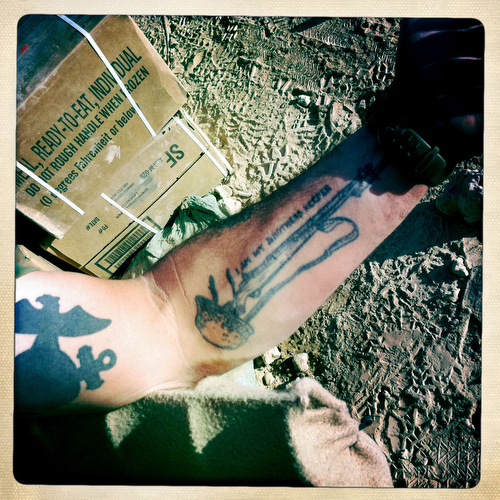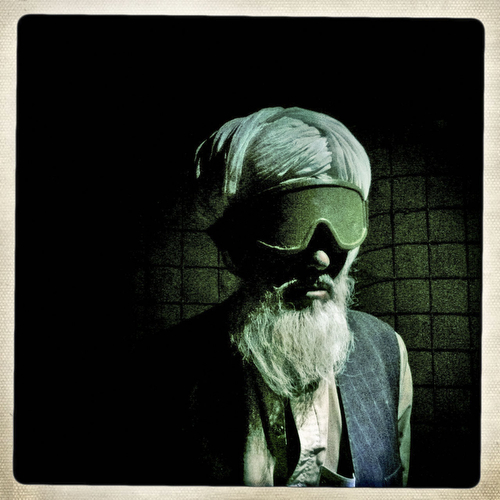Online mit den Marines in Helmand
Das Web macht neue Formen der Berichterstattung und des Journalismus möglich, und ein neues Projekt finde ich ganz besonders spannend: Die Begleitung eines Bataillons der U.S. Marines in Helmand, Afghanistan, mit einem Team von Journalisten – obwohl sich einige aus dieser Mannschaft nicht unbedingt als Journalisten bezeichnen würden.
Basetrack heißt das Projekt, und es gibt dazu eine Webseite (basierend auf der Blog-Software WordPress), natürlich eine Facebook-Seite und einen Twitter-Account (übrigens, Nebenbemerkung, gibt’s das alles auch für Augen geradeaus!…).
Der etwas andere Ansatz, wie es Initiator Teru Kuwayama in einem Interview mit dem Lens-Blog der New York Times ausdrückt: We create a pipeline between 1,000 Marines working in very austere, isolated conditions in southern Afghanistan and connect them to their mothers, their fathers, their wives, their girlfriends, their husbands and their kids. Nobody has more authenticity to talk about this war, its costs, its consequences, and maybe even offer some analysis about how this could be done better. That’s effectively what the project is. The stream of photographs we send out is embedded with news articles, bits of analysis, facts, figures.
Die Fotos sind offensichtlich alle mit einem Handy aufgenommen:
„I am my brother’s keeper“, tatooed on the arm of USMC Staff Sgt. Gonzales, alongside the USMC globe and anchor motif. OP (observation post) Kunjak, a small outpost held by US Marines (1st Battalion,8th Marines, Alpha Company) overlooking the town of Da Karez, near Musa Qala, Helmand province, Afghanistan. October 11, 2010 (Foto: Teru Kuwayama/Basetrack.org unter CC-Lizenz)
Afghan detainee at Patrol Base Talibjan, Helmand Province on November 7, 2010. The man was captured during a military operation after he was seen using a radio while spotting on US Marines during a firefight. (Foto: Balasz Gardi/basetrack.org unter CC-Lizenz)
Ich bin gespannt und behalte das Projekt im Auge. Ausdrücklich sieht das Basetrack-Team sein Projekt als einen Testlauf für andere, die auch solche Formen der Berichterstattung ausprobieren. Oder, wie es das Blog des Londoner Frontline-Clubs (bekannt geworden als zeitweises Versteck für Wikileaks-Gründer Julian Assange) formuliert: Covering the Marines on Facebook: embedded journalism goes open source.
(Allerdings könnte ich mir vorstellen, dass die Bundeswehr noch eine Weile braucht, ehe so etwas realisierbar ist. Schon mit TV-Projekten zur Begleitung von Einheiten am Hindukusch soll es Probleme geben.)





OT: Soldaten der deutschen Luftwaffe, die in den USA stationiert sind, sollen sich im Umfeld der Organisierten Kriminalität bewegen (S. 13 des Dokuments).
http://info.publicintelligence.net/ATF-OMGmilitary2010.pdf
Das ist aber seeeehr OT…
@T. Wiegold
Hatte die Tätowierung auf dem Photo gesehen, woraufhin ich mich an den Bericht über die Gangs erinnerte.
Der Stab Strategische Kommunikation fokussiert sich halt auf Bild, BamS und Glotze. Während erstere auch im eigenen Interesse eine Kampagne gegen die ARD fahren (und dabei geschickt zukleistern, dass die Bundeswehr es seit einigen Jahren schafft, Sinnvolles über ihre sauteuren Satelliten zu übertragen) oder die Guttenberg-Show am Hindukusch vermarkten, hoppeln Kerner und sein Team dem Minister und den Lagerinsassen auf den Schoß. Für Bilder von Kriegern ist da kein Platz. Na ja, da müssen sie die Bilder eben selbst machen: http://bendler-blog.de/2010/12/22/geschenktip-fur-krieger/